Lantinghei Sc Font
Lantinghei SC Demibold by? 2009, Beijing Founder Electronics Co.,Ltd. TAGS: lantinghei demibold 2009 beijing founder electronics This font is part of iOS 10 software package so it. Lantinghei SC Heavy by? 2010, Beijing Founder Electronics Co.,Ltd. Zvuk first blood. TAGS: lantinghei heavy 2010 beijing founder electronics This font is part of iOS 10 software package so it cannot be downloaded separately.
License NOTIFICATION OF LICENSE AGREEMENTYou have obtained this font software either directly from Linotype GmbH or together with software distributed by one of Linotype's licensees.This font software is a valuable asset of Linotype GmbH. Unless you have entered into a specific license agreement granting you additional rights, your use of this font software is limited to your workstation for your own use. You may not copy or distribute this font software. If you have any questions regarding your license terms, please review the license agreement you received with the software.General license terms and usage rights can be viewed at www.linotype.com/license.Generelle Lizenzbedingungen und Nutzungsrechte finden Sie unter www.linotype.com/license.Pour plus d'informations concernant le contrat d'utilisation du logiciel de polices, veuillez consulter notre site web www.linotype.com/license.Linotype GmbH can be contacted at:Tel.: +49(0)6172 484-418.

The Chinese characters are set in FounderType’s Lantinghei series (兰亭黑), designed by the foundry’s senior designer, Li Qi (齐立). The name reads “Lanting Gothic”, and “Lanting” references Chinese calligrapher Xizhi Wang (王羲之)'s famous work, Lanting Jixu (兰亭集序). Lantinghei’s regular and bold weights were later extracted, based on which Microsoft and Monotype collaborated to develop a very similar Microsoft YaHei (微软雅黑), the Windows UI typeface starting from Vista. YaHei’s bold weight is interestingly named “Negrata”. The skeleton features of some radicals are modified, and Segoe are packed into the font files for Latin coverage.
Monotype added the hinting data. As a commercial, print-focused typeface, Lantinghei was continually expanded after the Microsoft deal.
Microsoft again used LantingHei’s light weight for YaHei’s similar weight in 2013. Apple also partially licenses LantingHei to embed in OS X, with a simplified (Lantinghei SC) and a traditional (Lantinghei HK) variant.
Peiran, thank you so much! This information is very welcome.
I’ve created an entry and added a sample for — I hope I got it right. Apple also partially licenses LantingHei to embed in OS X, with a simplified (Lantinghei SC) and a traditional (Lantinghei HK) variant. I see a Lantinghei SC and a Lantinghei TC on my system, each in 3 weights, latter with a smaller character set. I assume TC (Traditional Chinese) = HK (Hong Kong)? YaHei’s bold weight is interestingly named “Negrata”.
Unlock your modem, router or phone easy! DC-unlocker is a program specialized in modems, routers and phones unlocking.. Walaupun kadang modem bawaan/bundling operatot tertentu lebih murah namun membeli modem unlock adalah pilihan terbaik berdasarkan pengalaman. Software unlock modem cdma terbaik dari.
On OS X, the bold styles of Segoe UI and Tahoma show up with the Spanish (or Catalan?) “Negreta” name, too. Looks like localization gone wrong.

Here’s a related: [] being a Microsoft font it has Microsoft names but no Mac names. So I think Apple pick the first name they see which happens to be “Tahoma Negreta” instead of the correct locale name and things go South after that [] •.
Florian, the type sample is right. I see you using the English version of Founder’s website on the typeface’s entry page.
It may be more accurate to point to the, with their own type specimen. My fault of not double-checking the names—it is indeed Lantinghei TC. But do note that TC is a morphology name, and HK is a locale name, so they don’t always equate. For example, OS X’s new Chinese UI typeface, PingFang (苹方), comes with an SC, a TC, and an HK variant. Though both “Traditional”, Hong Kong and Taiwan follow different official glyph standards. This often means that one glyph slot in Unicode is mapped to multiple variants.
For more of this information, see Adobe and Google’s Source Han Sans, the most technologically advanced typeface to date in terms of East Asian localization: and page As for the Negreta naming, I am slightly unsure that it is a technical oversight. Even Apple in their uses the name “Tahoma Negreta”.
This makes me think that there might be some intention in using this name instead of Bold. I might be wrong, though.